Introduction
Disease and insect control measures suggested in this guide are recommended only for home fruit production. When this program is followed, trees and small fruit plants should be reasonably free from insect and disease injury. This spray schedule is developed for the average conditions existing in New Hampshire.
The weather is the greatest variable related to pest control. Warm, wet weather in spring favors the development of apple scab, cedar apple rust, fire blight, mildew, rots, and many other diseases. Under such conditions, it may be necessary to spray more often to prevent infection. Dry, hot weather is often more favorable for insect population buildup, so it may be more difficult to control insects during hot, dry weather. If surface blemishes on fruit do not bother you, you may follow a less intensive schedule. One such minimal spray schedule for apples is indicated in the chart.
General Purpose Spray Mixtures
General purpose spray mixtures are useful for the control of common pathogens and insects that attack fruit, except plum curculio, peach tree borers, and pathogens that cause black knot of plum, cedar apple rust, fire blight, and peach leaf curl. Some mixes are labeled for tree fruit only. Check the label before you buy. The ingredients usually include one or more insecticides (such as carbaryl, permethrin, malathion) and one or more fungicides, usually captan, sometimes sulfur. Captan is generally considered a good choice for management of many fruit diseases. Sulfur is particularly good for powdery mildew, and is somewhat effective for scab, rust, and brown rot.
Reliance on a mixture simplifies spraying fruit. Since all pests do not always threaten your crop in combination, use of the mixture results in some unnecessary spraying. The choice is yours - total reliance on general-purpose mixtures is simple and convenient but can be wasteful at times, may harm non-target species and may increase the risk of pests and pathogens developing resistance to pesticides. Combining insecticides and fungicides in your sprayer tank as needed is more complex, but uses only what is required, when it is required.
Garden supply stores sell general purpose mixtures under a variety of names. The ingredient pesticides can also be purchased separately and mixed when used. Refer to the labels for precautions before mixing any pesticides.

The weather is the greatest variable related to pest control. Warm, wet weather in the spring favors the development of apple scab, cedar apple rust, fire blight, mildew, rots, and many other diseases.
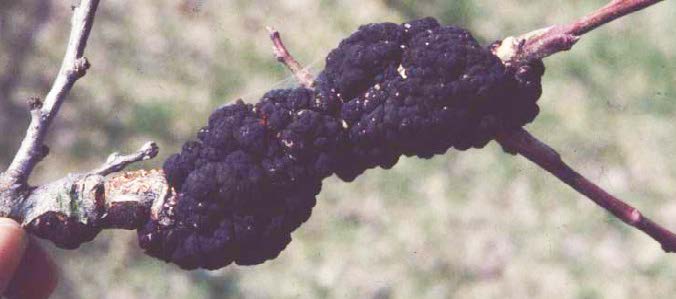
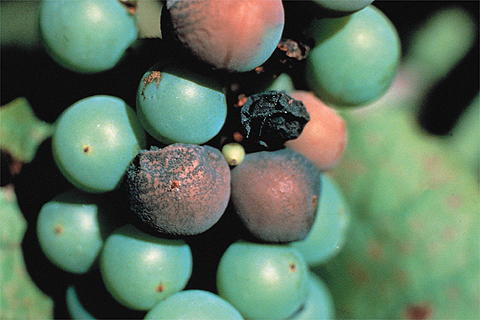
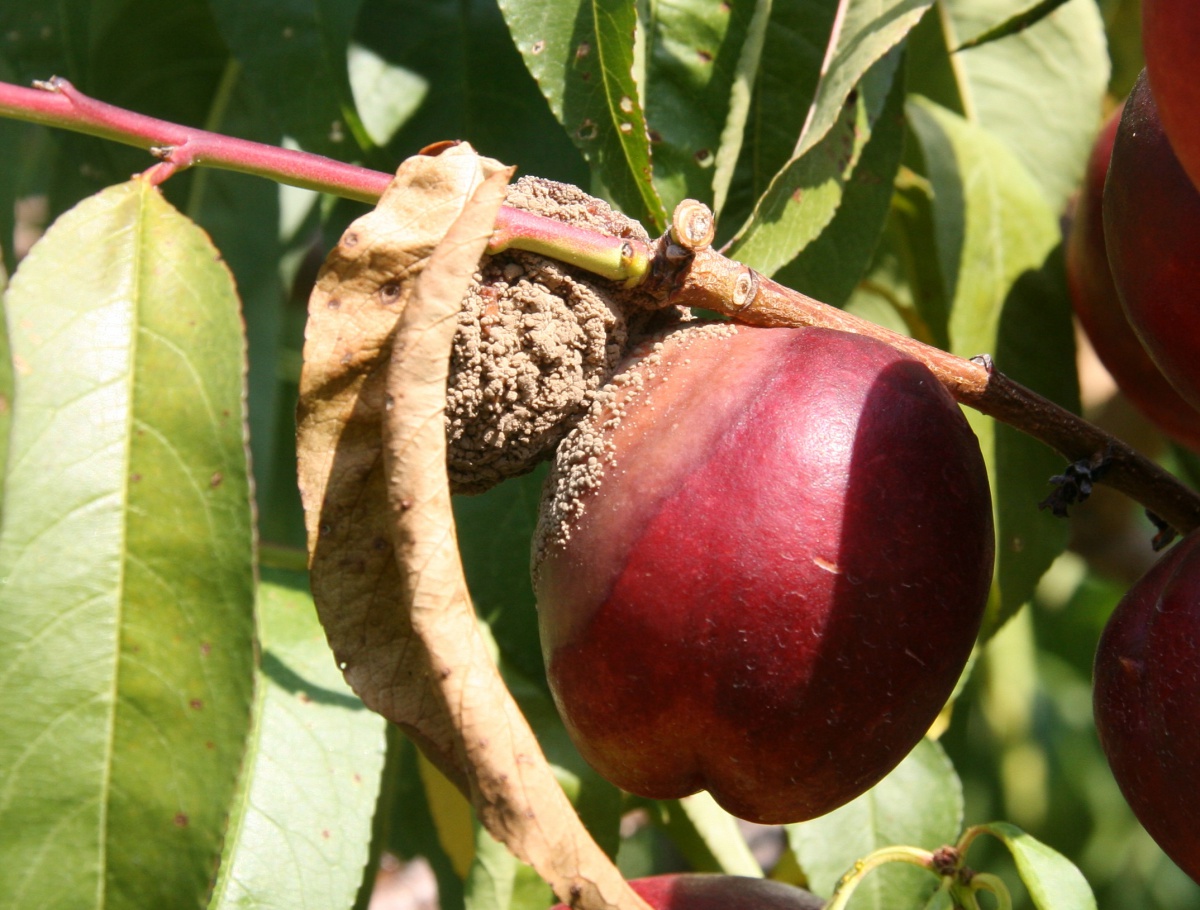
Supplemental Spray Materials
The proper use of supplementary spray materials can increase the yield of usable fruit. Bacillus thuringiensis (Biobit, Dipel, Javelin, Sok-BT, B.t.) is effective on foliage-feeding caterpillars. Sevin is registered for all of the listed crops. It is effective for many pests, including apple and blueberry maggots, Japanese beetles, spittlebugs and tent caterpillars. Some backyard products contain permethrin. It can be somewhat effective on plum curculio (a major, serious tree fruit pest), but not in the low concentrations available to backyard growers. To really control plum curculio, adding a supplemental spray (like carbaryl) is necessary. Spray oil can help control certain aphids, mites, scales, and pear psyllas on fruit trees (oils can also suppress some diseases). Copper soap (copper octanoate) is effective for cedar apple rust, fire blight and peach leaf curl. Myclobutanil is effective against brown rot and cedar apple rust. Propiconazole is effective for brown rot, and chlorothalonil is also labeled for brown rot. Bacillus subtilis (Serenade) is registered for fire blight and gray mold, Streptomyces lydicus (Actinovate) is labeled for small fruits for gray mold and powdery mildew, and potassium bicarbonate is effective for powdery mildew. The following sections will give examples and situations where supplementary sprays or sanitation may be helpful.
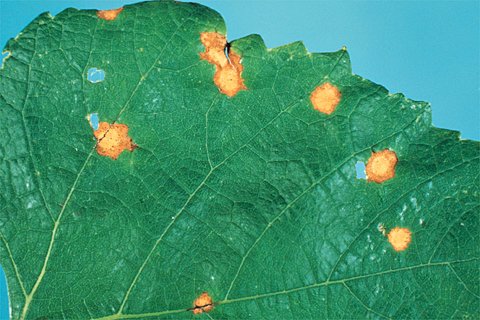
Diseases
Apple Scab — When growing scab resistant varieties, fungicides are rarely needed. Examples of resistant varieties are: Freedom, Jonafree, Liberty, MacFree, Nova Easygro, Prima, Pristine, and Redfree. If susceptible varieties are grown, rake and destroy fallen apple leaves in autumn.
Black Knot of Plum and Cherry — This disease causes black knots/ growths on twigs and spurs. It is controlled by cutting out and burning the diseased twigs in the fall, winter, or very early spring. All infected wild trees adjacent to the orchard should be destroyed, if possible, to prevent spread of the disease. Select resistant varieties of plum.
Black Rot of Grapes — The fungus causing this disease overwinters on all parts of the plant, but mummified berries on the ground or clinging to the vines are the major infection source in the spring. Removal of mummified fruit is important for management. Captan, copper soap, and myclobutanil are effective for control.
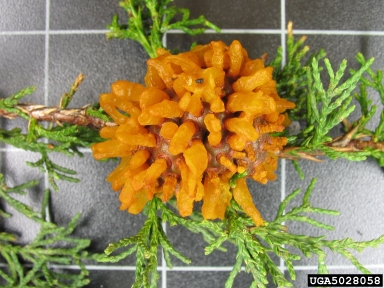

Brown Rot of Cherry, Peach and Plum — The fungus that causes this disease overwinters on mummified fruits hanging on the tree or on the ground. Clean up fallen fruit before, during, and after harvest. Remove and destroy all unharvested fruits and mummified fruits from trees after harvest. Captan, propiconazole, chlorothalonil, or myclobutanil (Immunox – Do not use Immunox Plus, it is not labeled for use on fruit) are registered.
Cedar Apple Rust — The fungus causing this disease overwinters on red cedar trees or junipers growing nearby. These trees should be removed, where practical, or remove galls in late winter to reduce infection on apple leaves and fruit. Rust can be controlled by applying copper soap (copper octanoate) prior to pink bud, or myclobutanil from half-inch green through pink.
Cherry Leaf Spot — The fungus causing this disease overwinters in infected leaves from the previous season. Raking fallen leaves in the autumn is essential for control. Myclobutanil and Captan are effective for control.
Fire Blight on Apple and Pear — This disease primarily affects spurs and twigs. It is controlled by cutting out and burning blighted branches as soon as they are seen. Cut at least 6-12 inches below any sign or symptom of the disease. After each cut, disinfect the pruning tools with a mixture of 1-part chlorine bleach and 9 parts water or 70% isopropyl alcohol. If there is a history of fire blight, copper soap can be applied as a late dormant spray (do not apply copper after green tip or fruit injury may occur).

Gray Mold of Strawberry and Raspberry— This disease is also called Botrytis fruit rot. Cultural practices that promote air circulation can reduce infections. A 3-spray program (just before bloom, full bloom, petal fall) may eliminate the need for fungicides during harvest. Botrytis also causes blossom blight on blueberries. Captan, Bacillus subtilis, and Streptomyces lydicus are registered.
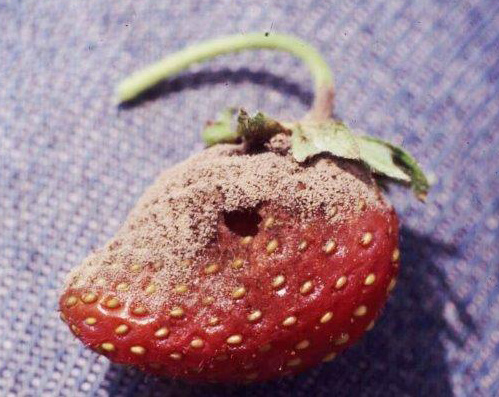
Peach Leaf Curl — Leaves become curled, crinkled, thickened, and red, pink or purple. The disease is controlled by applying copper soap after leaf drop in autumn (best) or before buds swell in spring.
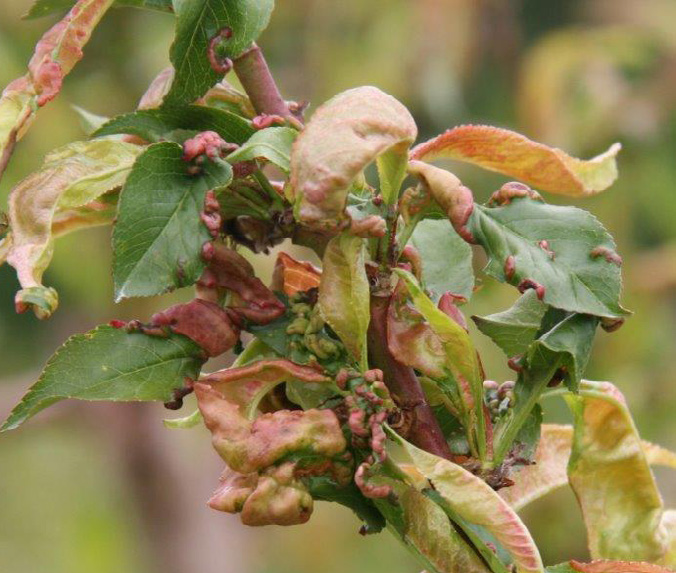
Powdery Mildew — Various formulations of wettable sulfur or potassium bicarbonate can aid in management of powdery mildew problems. Usually not a serious problem in New Hampshire, except on grapes. Some varieties of grapes are sensitive to sulfur.
Mummyberry of Blueberry — Fruit turn grayish, dry and drop off before ripening. Removing affected fruit before they fall, adding 2” of mulch and spring cultivation will help reduce infections.
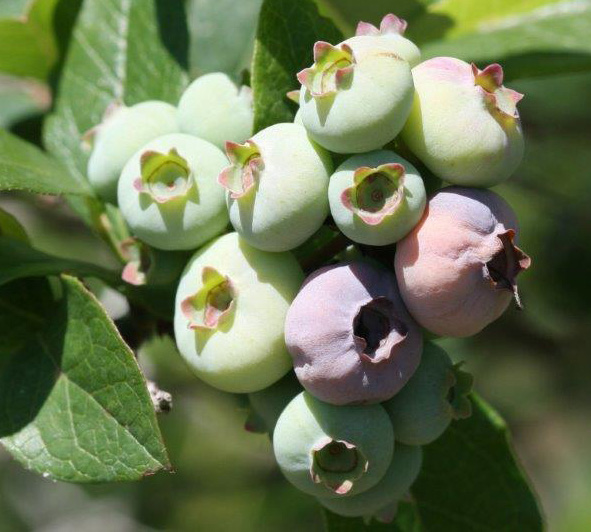
Insect Pests
Aphids — Insecticidal soap or malathion may help in aphid outbreaks, but most fruit-attacking aphids are held in check by predators.

Apple Maggot (Rhagoletis pomonella) — The larvae tunnel in apples in July & Aug. There are traps to guide if/when spraying is needed.
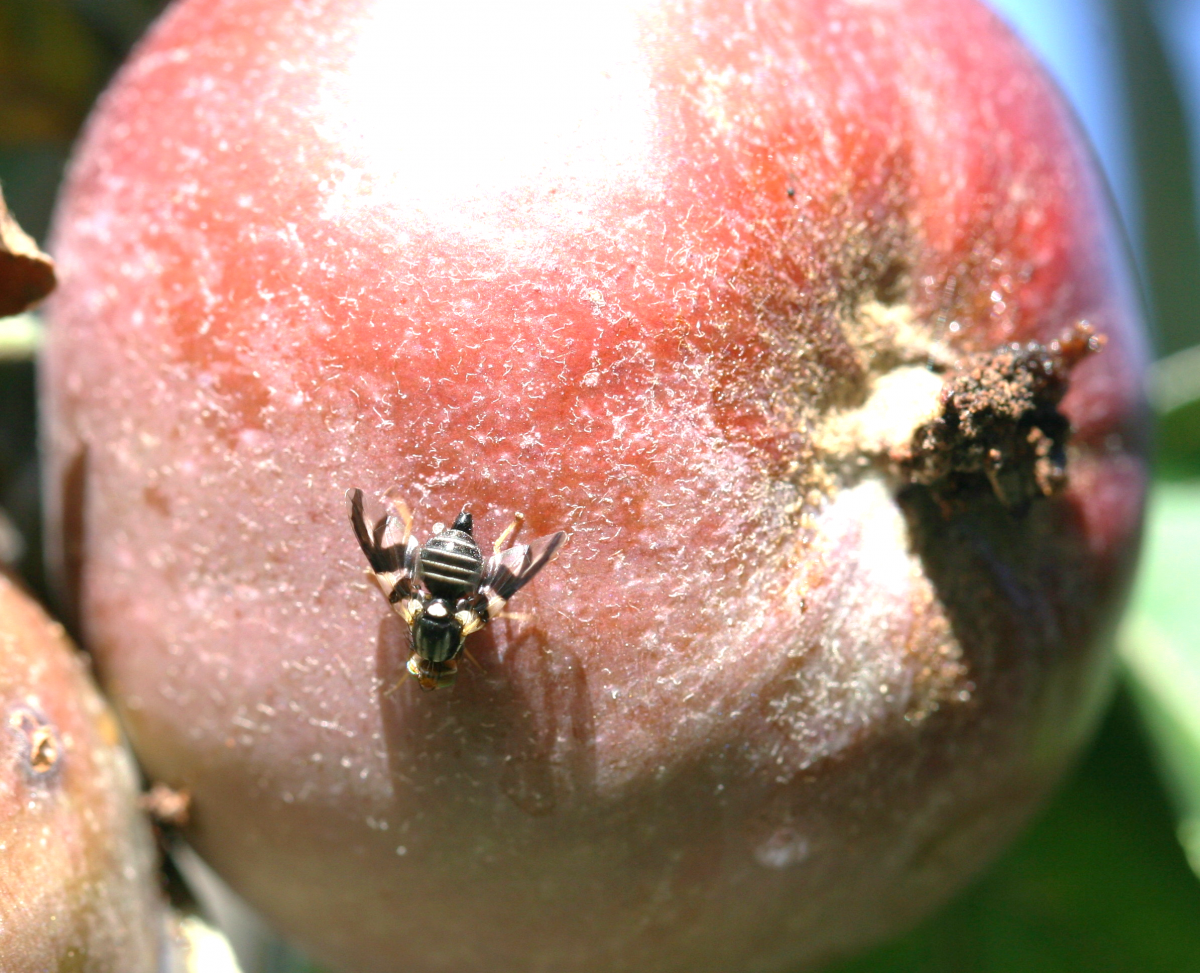
Codling Moth (Cydia pomonella) — The larvae tunnel in apple flesh, and feed on the seeds. They are usually controlled by sprays for curculio and apple maggot.
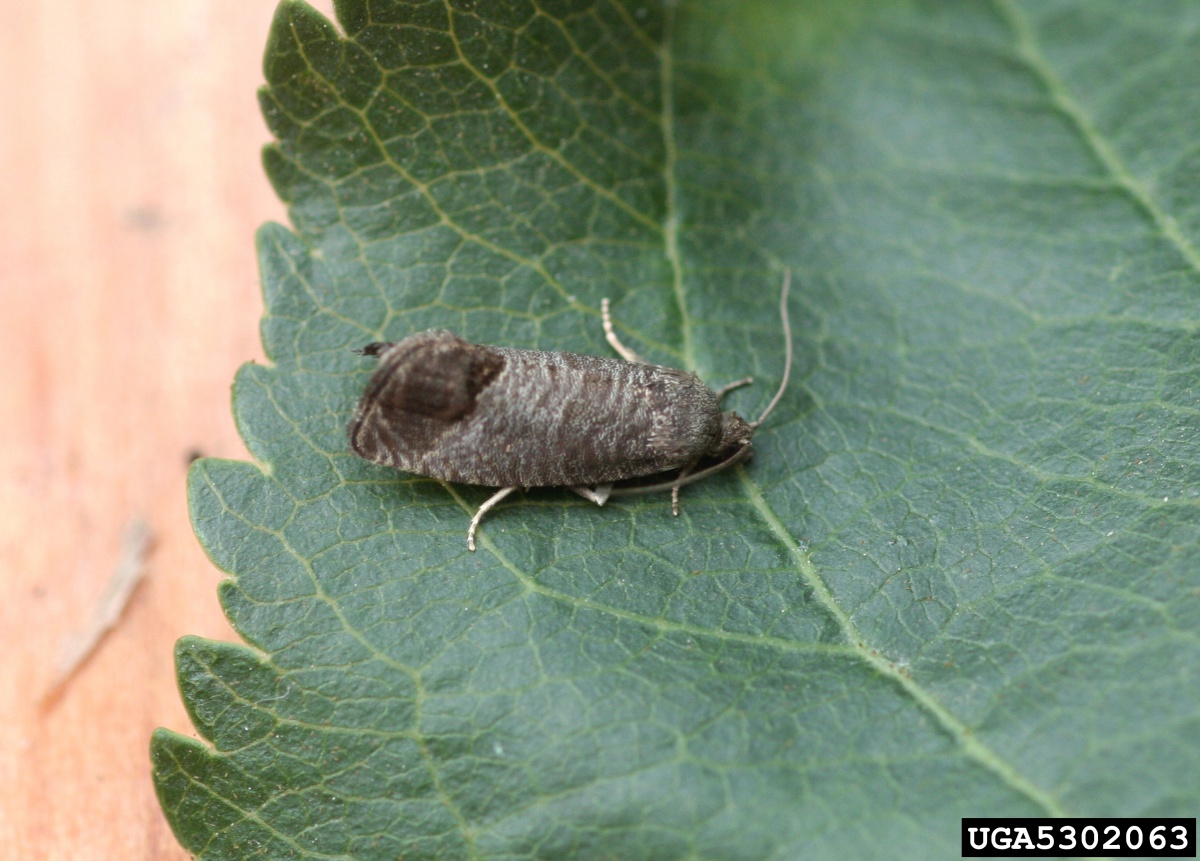
Leaf-Feeding Caterpillars— Gypsy moth (Lymantria dispar), tent caterpillars (Malacosoma spp.), fall webworms (Hyphantria cunea) and others may be controlled by applying a spray with Bacillus thuringiensis. Trade names include Dipel, Xentari, Javelin, Biobit, and others. The material must be eaten by caterpillars in order to work. Read the label before buying! Some strains of B.t. (Example: israelensis) do not work on caterpillars. The label will clearly indicate what pests are affected.
Japanese Beetle (Popillia japonica) — This insect is sometimes a problem; add carbaryl (Sevin) to the spray mixture or use carbaryl alone.

Pear Psylla (Cacopsylla pyricola) — Psyllas suck plant juices, and can stunt pears. Blackened leaves and twigs are signs of psyllas. High rates of nitrogen fertilizer often create psylla problems. Insecticidal soap may help with psyllas.
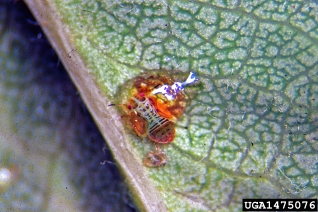
Peach Tree Borer (Synanthedon exitiosa) — These insects attack the trunk and main limbs of trees and are best controlled by spraying the lower trunk and the crotches thoroughly during July and August with an insecticide that lists peach tree borers on the label. None are now available for backyard use, so the best defense is to avoid mechanical injury to the trunks. Trunk injury greatly increases attractiveness to peach tree borers, to lay eggs.
Plum Curculio (Conotrachelus nenuphar)— This insect attacks very young apples, causing most of them to drop in June. Most all-purpose spray mixtures have too-low a concentration of permethrin to control curculios. Adding a spray of carbaryl when the fruit reach ¼ inch diameter will control this insect for seven days. But new labels require that a second application cannot be applied until 14 days later. Surround is a non-toxic alternative, but is very tricky to apply correctly.
Scale Insects — These are sometimes troublesome on backyard fruit plants. If they are a problem, apply a “superior” oil spray, 5-6 tbs. per gallon of water or 2 1/2 cups per 5 gallons of water, when buds begin to swell in the spring. Be sure to thoroughly wet the entire surface of all limbs and twigs, especially the top of plants and trees.

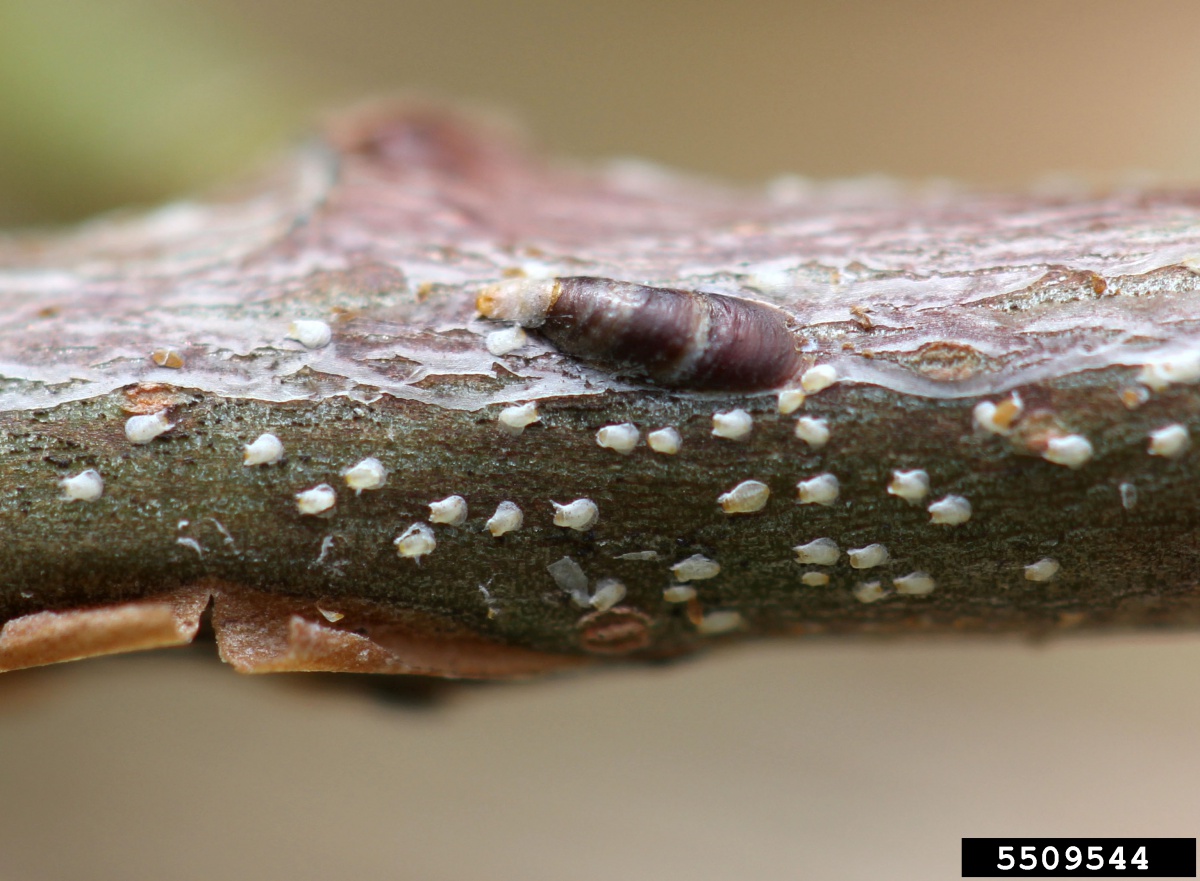
Soil Pests — Several soil insect pests such as white grubs may be troublesome in strawberry beds. To avoid such problems, eliminate grass from your beds and don’t locate the beds in areas where grass grew the previous year.
Spotted Wing Drosophila (Drosophila suzukii) — Spotted wing drosophila attacks ripe raspberries and blackberries, blueberries, plums, currants, some grapes (especially dark varieties with thin skins), some peaches and August-October maturing strawberries. Late-maturing varieties are the most heavily hit. Early maturing varieties of brambles and blueberries may escape significant attack. Attacked fruit turn sour and quickly rot. The most severe problems are in Rockingham & Hillsborough counties. Coös, Grafton and Carroll counties have the lowest problems. Effective insecticides include Entrust, Malathion (high rate), Exirel and others.
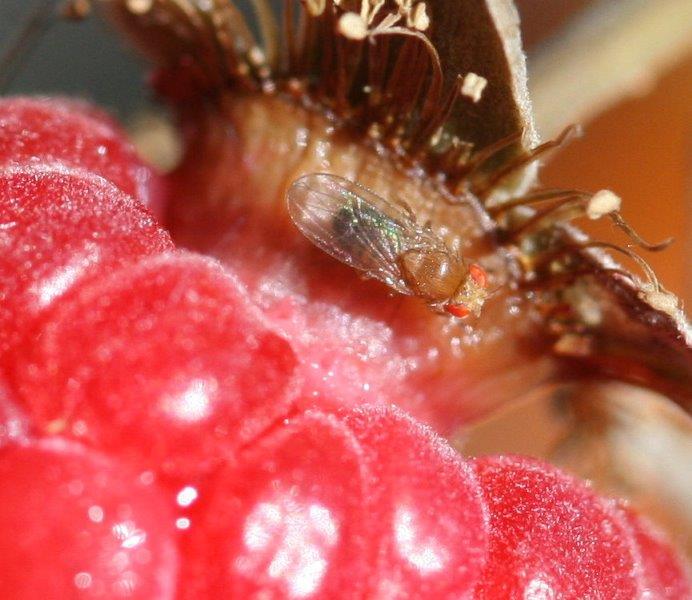
***Additional note, added by A. Wallingford May 2019: Cabaryl may now be more difficult for home owners to acquire.
It is unclear whether or not products containing the pyrethroid, zeta-cypermethrin, will offer equivalent control as carbaryl. However, these products will certainly have activity on common apple insect pests and offer an alternative to carbaryl.
Spray Schedule for Tree and Small Tree Fruits
Tables 1-4 summarize spray schedules for fruit trees and small tree fruits. Use appropriate materials for the pests indicated (consult pesticide labels). Watch for supplementary materials (time of application) and pests to be controlled.




***Additional note, added by A. Wallingford May 2019: Cabaryl may now be more difficult for home owners to acquire.
It is unclear whether or not products containing the pyrethroid, zeta-cypermethrin, will offer equivalent control as carbaryl. However, these products will certainly have activity on common apple insect pests and offer an alternative to carbaryl.
Got questions? The Ask UNH Extension Infoline offers practical help finding answers for your home, yard, and garden questions. Call toll free at 1-877-398-4769, Monday to Friday, 9 a.m. to 2 p.m., or e-mail us at answers@unh.edu.
Relevant Articles and Videos
Growing Great Fruits video interview series
Protecting Fruit Trees From Insects and Diseases webinar
Selecting the Appropriate Pesticide and Reading the Label article for gardeners
Managing Pests with Integrated Pest Management article for gardeners
Considering Organic and Natural Products article for gardeners
For more related fact sheets, go to extension.unh.edu/resources/category/Agriculture and extension.unh.edu/tags/growing-fruits-home
Stop! Read the label on every pesticide container each time before using the material. Pesticides must be applied only as directed on the label to be in compliance with the law. All pesticides listed in this publication are contingent upon continued registration. Contact the Division of Pesticide Control at (603) 271-3550 to check registration status. Dispose of empty containers safely, according to New Hampshire regulations.
Download the Resource for the complete fact sheet and a printable version.
Additional Video Resources
Do you love learning about stuff like this?
SUBSCRIBE TO GRANITE STATE GARDENING
A monthly newsletter for New Hampshire gardeners, homesteaders and plant-lovers of all kinds, that includes seasonal suggested gardening tips, upcoming events and articles with proven solutions for your garden and landscape.
Got questions? The Ask UNH Extension Infoline offers practical help finding answers for your home, yard, and garden questions. Call toll free at 1-877-398-4769, Monday to Friday, 9 a.m. to 2 p.m., or e-mail us at answers@unh.edu.


